-
CENTRES
Progammes & Centres
Location
 PDF Download
PDF Download 
Debosmita Sarkar, “SDGs and Structural Vulnerabilities: The Case of BIMSTEC Countries,” ORF Occasional Paper No. 348, February 2022, Observer Research Foundation.
Image Source: SDGs and Structural Vulnerabilities: The Case of BIMSTEC Countries
I. Introduction
‘Structural vulnerabilities’ can be defined as a country’s exposure to various economic and environmental shocks owing to its economic trajectory or certain geo-physical factors intrinsic to the economy.[1],[2] The economic shocks could include spillover effects of financial market disruptions or exchange rate shocks, arising in other parts of the world and disrupting the stability of domestic markets. For countries with a relatively more open economy, seen for instance in higher merchandise export concentrations, such shocks potentially have a larger impact. At the same time, geo-physical features such as long coast lines, large extents of dry or semi-arid regions, and monsoon-dependence of agriculture, leave an economy vulnerable to frequent environmental shocks and the rising risks associated with climate change.
Increasing risks due to structural vulnerabilities can limit the development opportunities of a country by generating inefficient resource use; lowering savings and consumption rates (at a macro level); increasing livelihood stresses like death or disease, loss of shelter, damage to property, and job losses; and lowering business sentiments by causing the process of structural economic transformation to stagnate. All these factors feed into each other, thereby trapping an economy into a low- or middle-income equilibrium trap. How much a country’s growth or development potential is impacted by these vulnerabilities, however, depends on its economic and social resilience.
A country’s ‘resilience’, meanwhile, can be defined as its ability to mitigate the risks associated with or alleviating the asymmetries in development arising from the effects of structural vulnerabilities.[3] Developmental asymmetries such as economic inequality despite rising income levels, gender disparity, and unwarranted migration rates adding to population pressure, are all outcomes of increasing vulnerabilities in today’s globalised world. The most vulnerable sections of the population in developing countries with low economic resilience are disproportionately exposed to external shocks in the presence of structural vulnerabilities. Therefore, any effort to mitigate structural vulnerabilities remains inadequate without consideration of its counterpart, i.e., resilience. Resilience-building is based on medium- or long-run policy interventions that ultimately lead to structural transformations which then organically mitigate the effects of such risks.[4],[5]
In the more developed countries, economic development planning, accounting for structural vulnerabilities, and building up resilience against these shocks and exposures is a common practice aimed at encouraging regional or community-focused economic development. The United States (US) Economic Development Administration’s (EDA) Comprehensive Economic Development Strategy (CEDS) is one such program.[6] For the resource-constrained developing world, the efforts have to emerge more organically as part of a larger development agenda.
Greater resilience across individuals and households can possibly reduce the effect of livelihood stresses emanating from exposure to adverse external shocks at the initial level, and thereby, arrest the cascading effects of such shocks for the economy at large. Therefore, developing countries must find a way to direct its efforts at development in a manner that augments human and social capital, in addition to physical capital formation and economic growth. Additionally, a larger stock of natural capital in these countries can effectively provide a cushion to the most vulnerable and thus contribute to relatively more equitable distribution of resources.
The United Nations (UN) Sustainable Development Goals (SDGs) capture this idea of a multi-faceted development agenda based on the confluence of efficiency, equity, and ecology.[7] While the promotion of resilience can be anchored to sector-specific, community-specific, short-term, or long-term interventions, this paper concentrates on the development of resilience through structural policies reflected in a country’s achievement of specific SDG targets.
Figure 1: Sustainable Development Goals and Economic Linkages
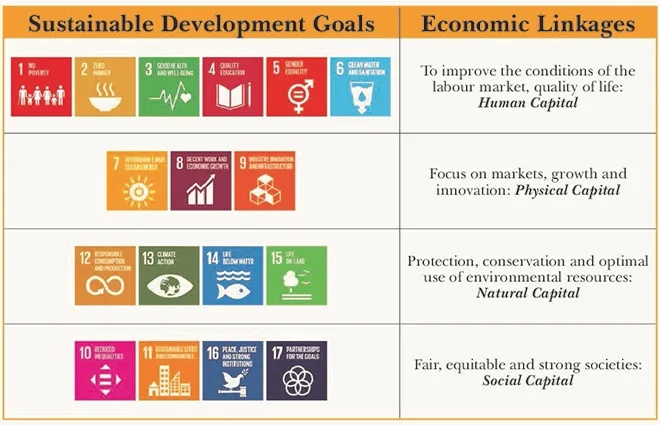
Source: Bhowmick, 2021 [8]
The analysis focuses on a representative group of seven countries from the developing world—Bangladesh, Bhutan, India, Myanmar, Nepal, Sri Lanka, and Thailand—which together form the Bay of Bengal Initiative for Multi-Sectoral Technical and Economic Cooperation (BIMSTEC) intra-regional bloc. These countries’ respective political and economic scenarios are complex, lending a unique character to the challenges they face in terms of addressing structural vulnerabilities. Besides similar economic, political and social context, the region is also increasingly threatened by climate change (owing to its geographical location), the effects of which are only aggravated by existing structural vulnerabilities. This paper will attempt to do the following:
The rest of the paper is structured as follows. Following the brief introduction, Section 2 discusses the elements of monitoring structural vulnerabilities across the developing world. Section 3 contextualises the scope for the BIMSTEC countries and Section 4 develops a framework for addressing structural vulnerabilities through progress towards the SDGs. The next two sections discuss the data sources, the methodology, and the results of the regression analysis. Section 7 concludes the paper.
II. Monitoring Structural Vulnerabilities in the Developing World
Amidst greater global integration, rising risks of climate change, and other pressures, it is becoming increasingly necessary for the developing world to focus on structural vulnerabilities and the factors that limit economic resilience. To account for the unique constraints to underdeveloped countries, the UN established a separate category of Least Developed Countries (LDCs) in 1971 to cover low-income developing countries that are faced with structural economic, social and geo-physical constraints to achieving sustainable development. To monitor the developing countries, the Committee for Development Policy (CDP), a subsidiary of the UN Department of Economic and Social Affairs (UNDESA), uses three criteria capturing their growth prospects, the vulnerabilities they are subject to, and their resilience towards these structural vulnerabilities.[9] The UNDESA also has an extensive architecture for reviewing and monitoring the progress and graduation of the LDC countries as well as for the impact assessment of newly graduated developing economies.
Figure 2: Criteria for monitoring developing countries
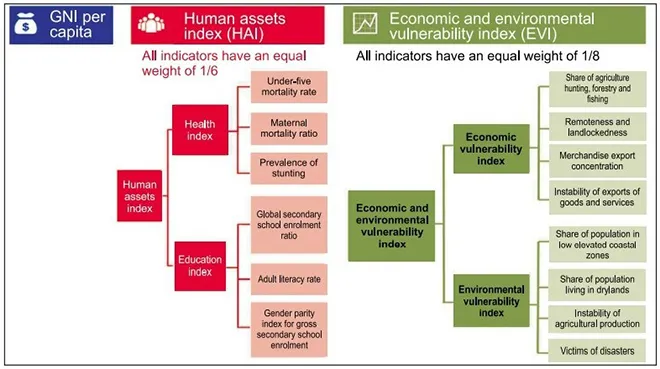
Source: Committee for Development Policy [10]
The UNDESA’s Economic and Environmental Vulnerability Index (EVI) provides a measurement of a country’s exposure to structural, geographical, and environmental shocks, without considering the transitory current domestic or international policies that might influence these factors to some degree.[11] The index is composed of two sub-indices of eight equally weighted component indicators.[12] The exposure index provides a measure of the ex-ante vulnerability of a country owing to its structural features, while the shock index presents an ex-post scenario of the extent and frequency of vulnerable exposures that a country is subject to.[a]
Another important measure of structural vulnerability is the Physical Vulnerability to Climate Change (PVCC) Index.[13] It has a narrower scope compared to the EVI and does not consider socio-economic challenges that impact the risks associated with climate change in developing countries. Therefore, the EVI provides a more comprehensive, and yet simple measure of structural economic and environmental vulnerabilities faced by the developing countries of the world.
At the same time, while the EVI provides a comprehensive measure of the medium-term structural vulnerabilities, it consciously excludes the resilience parameters. This is because the CDP uses the complementary criteria of per capita Gross National Income (GNI) and Human Assets Index (HAI) as a measure of a country’s resilience. However, the developing world today is faced with several other challenges, other than low income levels and inadequate access to basic healthcare and education that limit its resilience in the face of structural vulnerabilities. These factors could either be policy-driven or structural features that have been the outcomes of the growth trajectory pursued by these countries in the past. Moreover, there are interlinkages or feedback mechanisms operational between such challenges and the policy decisions that they drive in an economy, which add to the existing obstacles to sustainable development.
The challenges presented by the Covid-19 pandemic and its induced responses such as complete lockdowns and strict containment strategies, can serve as a case in point. The policy responses towards pandemic management have caused a significant economic fallout across countries, with severe consequences on efforts to reduce poverty, increase employment, and improve overall human welfare.[14] These consequences can serve to aggravate the existing structural challenges in an economy.
Today, 46 low-income countries are included in the UN’s LDC category. These countries receive extensive International Support Measures (ISMs) from various international institutions as well as their development partner countries and organisations. These include flow of resources from the international community and the developed world to the LDCs as well as South-South engagements. ISMs remain largely concentrated in the domains of international trade through preferential market access, trade agreements, as well as relaxation of World Trade Organization (WTO) rules; development cooperation through financial and technical assistance in capacity-building; and agency support through financial assistance for participation in international organisations such as the UN. All these measures provide a cushion for the LDCs against their structural vulnerabilities while they make progress towards achieving sustainable development, complemented by strong domestic institutions and governance and prudent policy-making tailored for country-specific threats and challenges. Once a country qualifies to graduate and the CDP reviews report their impact assessment, it is no longer eligible for assistance in the form of ISMs. Like all other developing countries, they then have to formulate their own development agenda for addressing the existing structural vulnerabilities.
Despite all the measures, the developing world has often experienced an erratic and fragile growth and development trajectory. Fifty years since the inception of the LDC category, only six countries have managed to complete their transition and graduate.[15] Even then, these countries along with the other developing countries remain mired in economic and social crises that have hindered their transition to high-income economies and, subsequently, into the developed world.
The Covid-19 pandemic has only compounded the challenges facing the developing world. It is important to carefully investigate the factors that have limited the development opportunities for these LDCs. This will highlight the importance of accounting for the sustainability of the growth or development trajectories pursued by the developing world.
III. Contextualising the Scope for the BIMSTEC Economies
BIMSTEC is a cooperation initiative involving seven countries, namely, Bangladesh, Bhutan, India, Myanmar, Nepal, Sri Lanka, and Thailand. The region is home to around 22 percent of the global population,[16] with a combined GDP of approximately USD 3.7 trillion a year.[17] The region has vast reserves of natural and human capital, which if mobilised in the right direction can significantly and sustainably augment its physical and social capital as well. This has crucial implications for the growth and development potential of the region.
However, the bloc has remained substantially dormant since its inception, and it was only in the more recent years that it has managed to gather some momentum.[18] This is because the member countries have been preoccupied with their own national development agenda, as well as contentious issues that carry geopolitical implications. The Rohingyas’ issue, for example, have had an impact on the progress of the regional bloc towards achieving its potential.[19] A renewed impetus to this platform should be viewed as an opportunity for the member states to chart a common framework of operation, taking cognisance of their individual domestic development agendas and priorities.
Four out of the seven member countries—i.e., Bangladesh, Bhutan, Myanmar, and Nepal—belong to the LDC category.[20] However, having satisfied the UNDESA’s graduation criteria for two consecutive triennial reviews, three of them have been recommended for graduation by the CDP by 2026. Myanmar, despite having fulfilled the graduation criteria for two consecutive triennial reviews, was deferred for recommendation by the CDP following concerns around political instability. It is due for an additional impact assessment review in 2024. Following graduation, these countries will lose access to a host of ISMs and LDC-specific support from their trading or development partners. This may have severe implications both on the medium- and long-run growth and development prospects of these countries, and will most likely impact the level of structural vulnerabilities that they face. As the countries begin to plan a smooth transition strategy through resource mobilisation in certain key sectors, it becomes necessary to identify the possible threats to their resilience against structural vulnerabilities. These considerations can then underpin their specific transition strategies.
The year 2019 marked the beginning of the ‘decade of action’ for the 2030 Agenda. However, the progress of BIMSTEC economies over the last three years towards the SDGs has remained largely stagnant. Of the 17 SDGs, these countries continue to face significant challenges with respect to as many as 12 areas of sustainable development.[21] Poverty eradication and quality education are two areas where progress has been consistent, although a few roadblocks still need to be addressed.
Figure 3: SDG Index Scores for the BIMSTEC Countries, 2019-2021
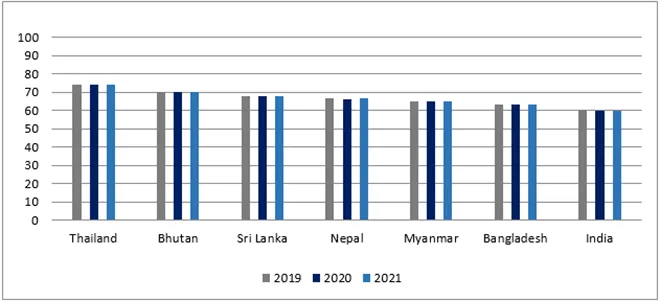
Source: Online Database, Sustainable Development Report 2021 [22]
According to the Sustainable Development Report 2021, Bangladesh has recorded notable progress with respect to improvements in SDG 1 (no poverty), SDG 4 (quality education), and SDG 13 (climate action). The country continues to face significant challenges with respect to poverty, hunger, gender parity, clean energy, decent work conditions, and inequality. India, for its part, continues to face significant challenges with respect to all the SDGs. Both Bangladesh and India endorse the SDG framework and integrate it with their overarching development strategy. However, such endorsements have not been backed by exclusively associated budget lines. Even with respect to their post-pandemic recovery plans, the two countries fail to accord the SDGs the necessary attention as a cornerstone for future growth and development.
The other five members of BIMSTEC also continue to experience obstacles to meeting targets related to eliminating hunger, promoting good health and well-being, gender equity, and reducing inequalities. Most notably, the BIMSTEC economies continue to lag in the conservation of natural resources. Trends indicate that they have shown little progress with respect to SDG 14 (life below water), and SDG 15 (life on land); most are regressing in these areas while a few exhibit relative stagnation.
The BIMSTEC countries therefore need to give renewed attention to the SDG framework. Since they are already part of the regional bloc and are facing common structural threats, the countries can use the grouping as a platform to identify complementary strategies for SDG implementation and further development that will serve the interest of all its members. They can enhance cooperation across the key sectors that BIMSTEC has identified: trade, investment and development; environment and climate change; security; agriculture and food security; people-to-people linkages; science, technology and innovation; and connectivity.
Table 1: Priority Sectors of Cooperation under BIMSTEC

Source: Sectors of Cooperation, BIMSTEC[23]
IV. Addressing Structural Vulnerability through Economic Resilience and Sustainable Development: Proposed Framework
The rationale behind exclusively monitoring developing countries is to support the least developed among them in pursuing a sustainable growth trajectory amidst their structural handicaps. Accordingly, the EVI index accounts for intrinsic factors like population size, extent of structural transformation of an economy, export concentration and instability of trade, and other geo-physical factors which, while having implications for growth and development, cannot be directly manoeuvred in the medium-run through policy interventions. This divorce from policy-induced effects, enables the identification of sustained threats posed to specific economies by economic or environmental factors. As such, improvements on this front—through reduction in the EVI values for a country—then indicate progress, growth and development. However, this does not necessarily mean that there is no scope for structural retrogression. It is against this backdrop that ensuring improvements in structural economic resilience in the long term assumes significance through the occasional, suitable policy interventions.
As discussed briefly earlier, the EVI index does not account for economic resilience because the UN’s monitoring criteria includes indicators of resilience, i.e., per capita GNI and the HAI index. Yet it is important to acknowledge that income growth, health, and education alone cannot ensure long-term resilience. While these may lead to capacity-building to some extent, it is also crucial to direct ample focus towards generating opportunities for the most efficient mobilisation of these resources leading to higher and more inclusive growth and development. Income growth, and improvements in education and health outcomes can substantially augment a country’s financial and human capital. Efficient resource mobilisation refers to maximising the use value of these available resources leading to creation of productive assets that can promote further development.[24] Efficiency of resource mobilisation can be influenced by a host of factors, some of which are economic and social inequality; joblessness and employment vulnerability; and excessive dependence on the natural environment.
The 2030 Agenda for Sustainable Development recognises and internalises this need for resilience and capacity-building through the inclusion of specific targets relating to disaster risk reduction. There are 24 targets of disaster risk reduction across 10 SDGs, directed towards establishing the role of resilience-building as a core development strategy (See Appendix I for a detailed list). In addition to these specific targets, it is essential to identify the scope for broad-based SDG achievements, leading to structural changes, towards addressing structural vulnerabilities in the region (both economic and environmental).
The framework of this study attempts to capture five broad areas of structural transformation cutting across several SDGs and primarily relating to the domains of human, social, and natural capital. These become particularly relevant in the context of complementing the BIMSTEC countries’ efforts towards industrial, infrastructure and connectivity development.
Table 2: Domains of Structural Transformation and Related SDGs

Source: Author’s own
Inequality is detrimental to the development process because it perpetuates existing social and economic divides. According to the Oxfam Inequality Report (2019), societies with higher inequality are marked by higher incidences of poverty, more authoritarian governments (which in turn has implications on people’s freedoms, such as of speech, especially for the marginalised), and lack of trust, higher crime rates, and poor access to health services and education. These curb the opportunities of development.[25] Moreover, the brunt of inequality is largely borne by the women, which then also perpetuates or even widens the gender gap.[26]
By depriving individuals of adequate agency, economic and social inequality negatively impact their resilience-building capacity, in turn making society more vulnerable to external shocks. High levels of inequality accompanied by rising vulnerabilities also impact domestic resource mobilisation through excessive precautionary savings in the economy, while consequently lowering incentives for private investments.[27] These again feed into the existing structural vulnerabilities by limiting prospects for diversification. Domestic resource mobilisation is also often seen as an essential buffer against the external financial shocks that threaten developing countries.
Gender gaps in labour force participation, besides limiting earning opportunities for women, also lead a larger share of women to seek out employment in the informal sector (at very low wages, if at all).[28] In India, the construction sector, for example, is highly gendered, with women mostly engaged in low-skilled and low-wage work.[29] These women are also prone to occupational hazards that pose serious health risks. An even worse scenario is that a large number of women remain engaged in unpaid domestic and care work or as contributing family workers. Encouraging higher participation of women in the economy can lead to more efficient resource allocation and higher total factor productivity by driving the economy towards a more competitive market.[30] Therefore, incentivising and enabling female labour force participation can accentuate income levels in the economy, both in the immediate and long term, through higher human capital formation owing to women’s higher propensity to invest in a child’s education.[31]
Employment vulnerability and job losses directly impact the earning opportunities of individuals and their families, their patterns of savings and consumption, and access to resources like health and education, limiting their economic resilience. In the long run, this also impacts the prospects for growth and investment in the economy. Long spells of high unemployment also lead to significant deterioration of the quality of the workforce due to reduced productivity, limit their social mobility, and contribute to declining re-employment wage rates leading to still lower prospects of growth and resilience.[32]
To be sure, high unemployment rates have severe implications in developed and developing countries alike. However, for the more populous developing nations, this also leads to subsequent high degree of informalisation of the workforce and an increasing engagement of workers in the vulnerable employment sectors.[b] These workers are less likely to earn adequate wages (or sometimes, any wages at all), and they remain deprived of social security as well as any kind of agency (economic, political or social). There is no denying, however, that such employment still acts as a cushion by engaging a fraction of the workforce, albeit with limited economic opportunities, who fail to get formal employment or adequate social protection from national institutions. Greater institutional support to these workers in the form of higher social security, in addition to efforts at employment generation, can contribute to resilience-building against structural vulnerabilities.
Another significant factor for both economic and environmental vulnerability is export concentration of primary products. In economic terms, price volatility is less significant for export of service or manufactured goods as it is for primary goods and even more specifically, natural resources. By extension, the more a country’s domestic production is derived from use of natural resources, the more it is at risk from exogenous shocks.[33] Moreover, unsustainable reliance on natural resources has ecological and environmental implications affecting the overall resilience of the indigenous populations. A country’s environmental resources form the stock of natural wealth of the economy. As public goods, these resources help offset the effects of wealth and income inequality on the most vulnerable and the poor by supporting their livelihoods.[34]
Therefore, increasing rent extraction from the natural environment can lead to scarcity in the available stock of natural capital, thereby directly impacting the economic resilience of the most vulnerable who are largely dependent on ecosystem services. Decreasing dependence on natural resources and preventing liquidation of a country’s natural assets, by increasing diversification of the export bundle through development of intermediate and finished goods industries not only reduces export concentration but is also in line with the ideas of sustainable development.
The following sections will identify and measure the degree to which these structural factors may have impacted resilience-building in the BIMSTEC countries over the previous two decades. These considerations can then underpin the transition strategies of the graduating countries as well as the development strategies of the other members of the intra-regional bloc, providing them with a common framework for targeting their structural vulnerabilities. While the study uses the premise of the BIMSTEC countries, it can provide indicative evidence towards expanding the scope of UN’s monitoring criteria for developing countries to include other factors that contribute to economic resilience. However, the universality of the significance of these structural indicators of resilience across all countries remains a scope for further study.
V. Data Sources and Methodology
The analytical framework used in this study entails investigating whether the structural factors discussed in the previous section have a statistically significant impact on the economic resilience of countries. These structural factors are economic and social inequality; unemployment rates and employment vulnerability; and undue reliance on natural resources. In the absence of a composite measure of resilience, this analysis uses a counterpart variable — structural vulnerability—to test the hypothesis. The framework is built to highlight the interlinkages between the various forms of capital embedded within the SDGs framework.
The model under investigation can be represented by the following equation (1):

Where, refers to structural vulnerabilities that the economies are subject to, i.e., the dependent variable, variable includes both economic and social inequality,
variable includes unemployment rates as well as share of vulnerable employment in total employment,
simply, refers to the natural resource rents extracted as a share of the gross domestic product (GDP),
accounts for levels of income and human asset in the country, taken together,
α, β, γ, δ and ρ are the parameters, with regression estimates of the slope parameters denoting the elasticities,
ε is the random-disturbance error term, and, the prefix refers to the logarithm scale.
The corresponding indicators for each variable are shown in Table 3, along with their data sources:
Table 3: Indicators and Data Sources
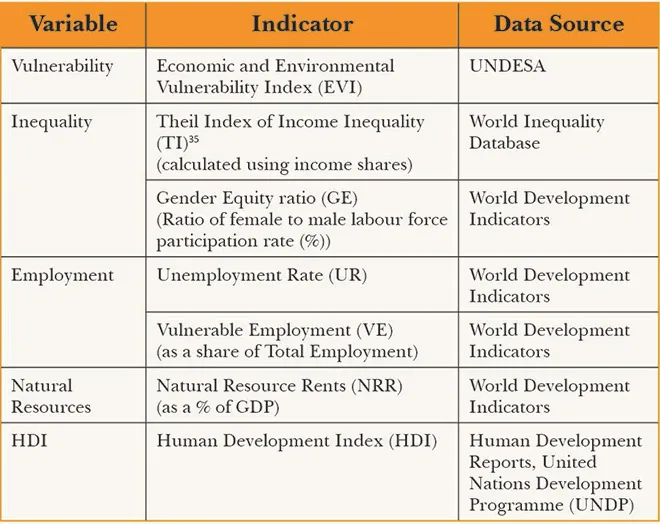
Source: Author’s own
Data has been collated for the seven BIMSTEC member countries for the period between 2002 and 2019. A panel data regression model of log-linear form has been constructed by modification of equation (1), as represented below:

The model investigates the causal relationship between economic vulnerability and structural factors like income inequality, gender equality, unemployment rates, employment vulnerability, and dependence on natural resource extraction, while accounting for the levels of human development which already feature in the UN’s LDC classification criteria. Here, the statistical significance of the estimated values of the slope coefficients are of interest. A statistically significant relationship between the variables under study would imply that these factors significantly influence the degree of exposure to shocks arising from economic and environmental vulnerabilities, and thus has an impact on the extent of economic resilience to structural vulnerabilities for these countries. For the regression exercise, a panel data linear regression model with fixed effects was used initially.
Post-estimation tests confirmed the presence of heteroskedasticity, serial auto-correlation, and cross-sectional correlation. While these results are indicative of a simultaneous relationship between the dependent and independent variables, the model specification here is driven by the hypothesised causal relationship emerging from the specific research question that the study tries to address. Accordingly, a linear panel regression model with panel corrected standard errors[35],[36] was used for obtaining the final estimation results. Further details of the regression exercise are summarised in the appendix.[37]
VI. Results and Discussion
The result for the regression model represented in (2) is given below as (2a), where the figures in parenthesis reflect the p-values associated with the coefficients,

All explanatory variables included in the model are statistically significant in explaining the variations in the economic and environmental vulnerability index scores for the BIMSTEC member countries. The estimated coefficient for income inequality is 0.1047 (positive and significant at 5% level of significance). This indicates that a one-percentage point increase in income inequality leads to a 0.1 percent increase in economic and environmental vulnerability index score through reductions in economic resilience of the vulnerable section of the population. Similarly, the elasticity of EVI in response to changes in all other independent variables of interest can be interpreted as summarised in Table 4.
Table 4: Summary of Results

Source: Author’s own
Therefore, it can be inferred that all these structural features, in addition to improvements in income levels and human asset, are statistically significant in explaining variations in economic and environmental vulnerabilities and can accordingly contribute to resilience-building.
Figure 4: Income Inequality in the BIMSTEC Countries (2002-2019)

Source: Author’s own
While countries like Bangladesh, Nepal and, most prominently, Bhutan have managed to reign in the income inequalities at comparatively low levels while making progress towards higher per capita income, Sri Lanka and Thailand have followed a more erratic path. Although the inequality in these economies have largely stabilised in the recent years, the figures are considerably higher when compared to their regional partners mentioned earlier. This has limited, and in some cases reduced, their ability to address structural vulnerabilities through resilience-building.
India, most notably among all the BIMSTEC members, has significantly high income inequality which has limited the efficiency of its efforts at building up economic resilience. Moreover, wealth inequality in the country has grown at a faster pace compared to income inequality.[39] In the likely scenario that the overhang of wealth inequality on the economic resilience of a large section of the population is larger than that of income inequality,[40] the situation becomes even worse for countries like India.
Figure 5: Female-to-Male Labour Force Participation Ratio in the BIMSTEC Countries (2002-2019)
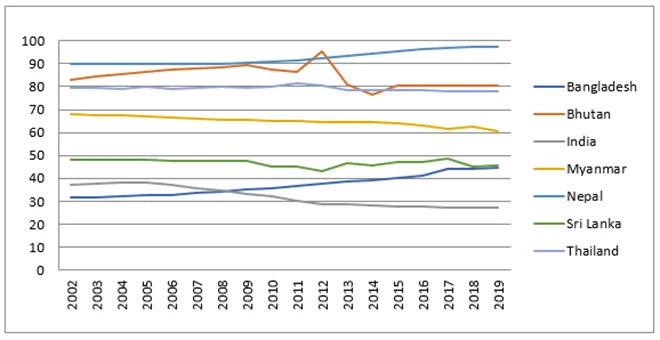
Source: Author’s own
Figure 6: Trends in Unemployment Rate in the BIMSTEC Countries (2002-2019)
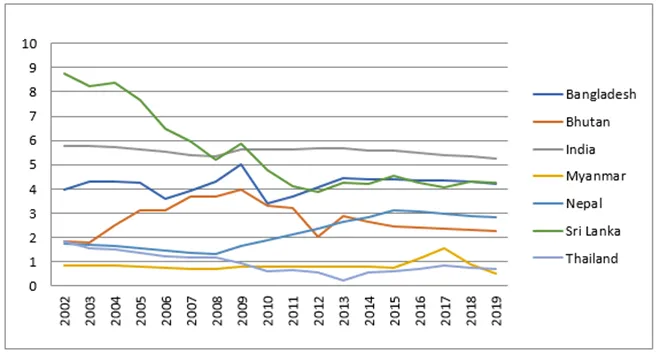
Source: Author’s own
The volatility of employment in these countries, as can be seen in Figure 6, also indicates frequent cyclical fluctuations in the business cycle. A volatile growth trajectory, in turn, makes the economy more vulnerable to trade or investment shocks by reducing the reliability of market forces. It is therefore essential to secure a sustainable increase in employment rates to ensure higher economic resilience.
Figure 7: Share of Vulnerable Employment in Total Employment in the BIMSTEC Countries (2002-2019)
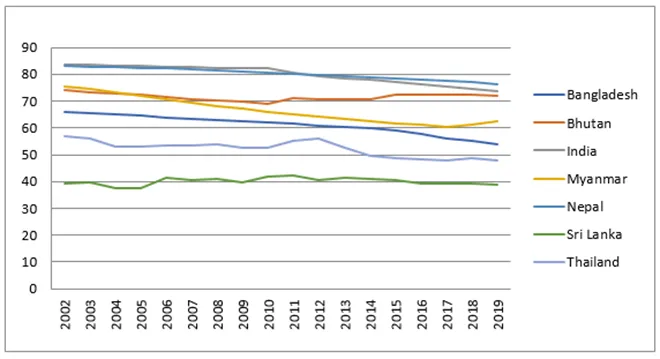
Source: Author’s own
Except for Sri Lanka, all other BIMSTEC members have a large share of their workforce engaged in vulnerable employment. In the absence of formal work arrangements in these countries, the market forces have generated a sufficiently large informal economy to absorb the excess labour supply to some degree. While these sectors have provided a safety net for a large section of the population over the years, there is no denying that there is an absence of adequate or even the necessary level of social protection for these workers. Besides indicating a severe lack of formal avenues of employment, it also points towards possibilities of productivity loss through disguised unemployment. When the Covid-19 pandemic first hit in early 2020, most countries responded by shutting down their economies through state-imposed lockdowns, and as a result arrested the market forces from operating. The informal economy and vulnerable sectors of employment that had acted as a cushion so far suddenly ceased to operate, pushing a large number of people in these countries to the brink of, or below the poverty line.
Figure 8: Natural Resource Rents as a Share of GDP in the BIMSTEC Countries (2002-2019)
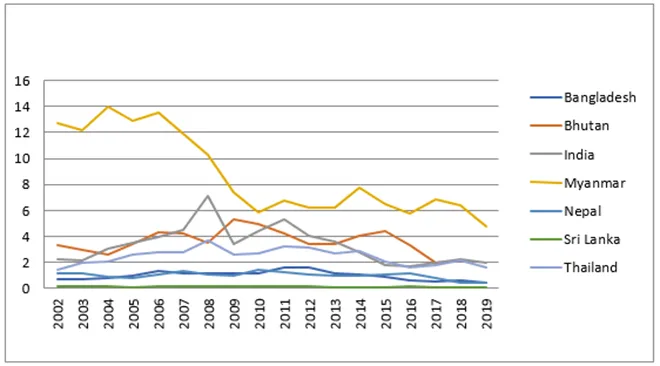
Source: Author’s own
Sri Lanka has a very low share of natural resource rents (expressed in terms of its GDP). Most of the BIMSTEC members have failed to significantly reduce their reliance on the available natural resources over the years. Despite considerable increases in the overall income levels and structural transformation to more industrialised or service-based economies, the share of natural resource rents has remained largely stable in the recent years, indicating increase in rent extraction from natural capital assets. This has been the case for all other countries, except Myanmar, as well as India and Bhutan to some extent. However, while Myanmar has managed to reduce its share of resource rents, it still remains the highest extractor among the others. This indicates a trend towards increasing reliance and over-utilisation of the environmental resources without commensurate conservation efforts.
VII. Conclusion
This analysis identifies five broad principles that can guide efforts towards capacity-building and developing economic resilience in the BIMSTEC countries.
The imperatives for sustainable development of the BIMSTEC countries, enabling greater economic resilience-building against structural vulnerabilities, can be realised through renewed focus of the members on specific sectors of cooperation, namely, trade, investment and development; environment and climate change; and agriculture and food security. Cooperation to promote regional trade and investment can significantly improve the scope for growth of domestic industries as well as increase the stability of trade volumes and capital flows for all the countries within the region. This becomes all the more important for the graduating countries as they eventually lose access to the preferential market access and relaxations under the WTO rules. This also has implications for employment generation.
The structural constraints faced by the agriculture sector in most of these economies also play a key role in dictating the overall employment scenario as well as the socio-economic position of a large section of its population. Relaxing these constraints can thus be a crucial step forward towards higher resilience. Moreover, with the aggravating climate risks today, the agriculture sector becomes even more vulnerable. Acknowledging this, cooperation for environmental conservation and implementation climate action plans was identified as one of the priority sectors by the regional bloc in 2009. Continued and enhanced cooperation in this area has become more critical today.
While the study uses the premise of the BIMSTEC countries to guide the development of an economic resilience framework, it acknowledges that it does not provide for an exhaustive list of indicators that could either directly or indirectly contribute to the ability of a country to deal with structural vulnerabilities. While keeping up with the UN’s focus on the domain of human capital asset as a measure of economic resilience, the above framework tries to highlight the existing interlinkages between different forms of capital using some select indicators. In this context, the study has its limitations in terms of exclusion of physical and finance capital from the framework. Moreover, a subsequent analysis on the path dependency of these explanatory variables, along with their nature and degree of convergence/divergence within the BIMSTEC countries, can be explored in future analyses to identify patterns that can enable the creation of country-specific as well as a regional policy matrix.
Yet, the study has some serious implications of its own. First, this can guide the development of specific transition strategies underpinned by these guiding principles to ensure sustainable development of the graduating countries in the absence of LDC-specific support. Second, it can initiate the development of a more comprehensive measure of economic resilience as a complementary criterion for the UN’s LDC classification. Third, the inclusion of the other developing countries (ODCs) such as India, Sri Lanka and Thailand in the sample provides indicative evidence towards the validity and usefulness of this framework for the developing world at large in the context of making sustainable progress towards economic resilience against structural vulnerabilities
Appendix
| Sustainable Development Goal | Related disaster risk reduction target |
| Goal 1: End poverty in all its forms everywhere | Target 1.5: By 2030, build the resilience of the poor and those in vulnerable situations and reduce their exposure and vulnerability to climate-related extremes and other economic, social and environmental shocks and disasters. |
| Goal 2: End hunger, achieve food security and improved nutrition and promote sustainable agriculture | Target 2.4: By 2030, ensure sustainable food production systems and implement resilient agricultural practices that increase productivity and production, that held maintain ecosystems, that strengthen capacity for adaptation to climate change, extreme weather, drought, flooding and other disasters and that progressively improve land and soil quality. |
| Goal 3: Ensure healthy lives and promote well-being for all at all ages | Target 3.d: Strengthen the capacity of all countries, in particular developing countries, for early warning, risk reduction and management of national and global health risks. |
| Goal 4: Ensure inclusive and equitable quality education and promote lifelong learning opportunities for all development | Target 4.7: By 2030, ensure that all learners acquire the knowledge and skills needed to promote sustainable development including, among others, through education for sustainable development and sustainable lifestyles, human rights, gender equality, promotion of a culture of peace and nonviolence, global citizenship and appreciation of cultural diversity and of culture’s contribution to sustainable |
| Target 4.a: Build and upgrade education facilities that are child, disability and gender sensitive and provide safe, non-violent, inclusive and effective learning environments for all. | |
| Goal 6: Ensure availability and sustainable management of water and sanitation for all. | Target 6.6: By 2020, protect and restore water-related ecosystems, including mountains, forests, wetlands, rivers, aquifers and lakes. |
| Goal 9: Build resilient infrastructure, promote inclusive and sustainable industrialization and foster innovation | Target 9.1: Develop quality, reliable, sustainable and resilient infrastructure, including regional and trans-border infrastructure, to support economic development and human well-being, with focus on affordable and equitable access for all. |
| Target 9.a: Facilitate sustainable and resilient infrastructure development in developing countries through enhanced financial, technological and technical support to African countries, least developed countries, landlocked developing countries and small island development states. | |
| Goal 11: Make cities and human settlements inclusive, safe, resilient and sustainable | Target 11.1: By 2030, ensure access for all to adequate, safe and affordable and basic services and upgrade slums. |
| Target 11.3: By 2030, enhance inclusive and sustainable urbanization and capacity for participatory, integrated and sustainable human settlement planning and management in all countries. | |
| Target 11.4: Strengthen efforts to protect and safeguard the world’s cultural and natural heritage | |
| Target 11.5: By 2030, significantly reduce the number of deaths and the number of people affected and substantially decrease the direct economic losses relative to global gross domestic product caused by disasters, including water-related disasters, with a focus on protecting the poor and people in vulnerable situations. | |
| Target 11.b: By 2020, substantially increase the number of cities and human settlements adopting and implementing integrated policies and plans towards inclusion, resource efficiency, mitigation and adaptation to climate change, resilience to disasters, and develop and implement, in line with the Sendai Framework for Disaster Risk Reduction 2015- 2030, holistic disaster risk management at all levels | |
| Target 11.c: Support least developed countries, including through financial and technical assistance, in building sustainable and resilient buildings utilizing local materials. | |
| Goal 13. Take urgent action to combat climate change and its impacts | Target 13.1: Strengthen resilience and adaptive capacity to climate-related hazards and natural disasters in all countries |
| Target 13.1: Strengthen resilience and adaptive capacity to climate-related hazards and natural disasters in all countries | |
| Target 13.3 Improve education, awareness raising and human and institutional capacity on climate change mitigation, adaptation, impact reduction and early warning. | |
| Target 13.a Implement the commitment undertaken by developed-country parties to the United Nations Framework Convention on Climate Change to a goal of mobilizing jointly $100 billion annually by 2020 from all sources to address the needs of developing countries in the context of meaningful mitigation actions and transparency on implementation and fully operationalise the Green Climate Fund through its capitalization as soon as possible. | |
| Target 13.b Promote mechanisms for raising capacity for effective climate change-related planning and management in least developed countries, including focusing on women, youth and local and marginalized communities. | |
| Goal 14. Conserve and sustainably use the oceans, seas and marine resources for sustainable development | Target 14.2 By 2020, sustainably manage and protect marine and coastal ecosystems to avoid significant adverse impacts, including by strengthening their resilience, and take action for their restoration in order to achieve healthy and productive oceans |
| Goal 15. Protect, restore and promote sustainable use of terrestrial ecosystems, sustainably manage forests, combat desertification, and halt and reverse land degradation and halt biodiversity loss | Target 15.1 By 2020, ensure the conservation, restoration and sustainable use of terrestrial and inland freshwater ecosystems and their services, in particular forests, wetlands, mountains and drylands, in line with obligations under international agreements. |
| Target 15.2 By 2020, promote the implementation of sustainable management of all types of forests, halt deforestation, restore degraded forests and substantially increase afforestation and reforestation globally. | |
| Target 15.3 By 2030, combat desertification, restore degraded land and soil, including land affected by desertification, drought and floods, and strive to achieve a land degradation neutral world | |
| Target 15.4 By 2030, ensure the conservation of mountain ecosystems, including their biodiversity, in order to enhance their capacity to provide benefits that are essential for 19 sustainable development. | |
| Target 15.9 By 2020, integrate ecosystem and biodiversity values into national and local planning, development processes, poverty reduction strategies and accounts. |
The views expressed above belong to the author(s). ORF research and analyses now available on Telegram! Click here to access our curated content — blogs, longforms and interviews.

Debosmita Sarkar is an Associate Fellow with the SDGs and Inclusive Growth programme at the Centre for New Economic Diplomacy at Observer Research Foundation, India. Her ...
Read More +